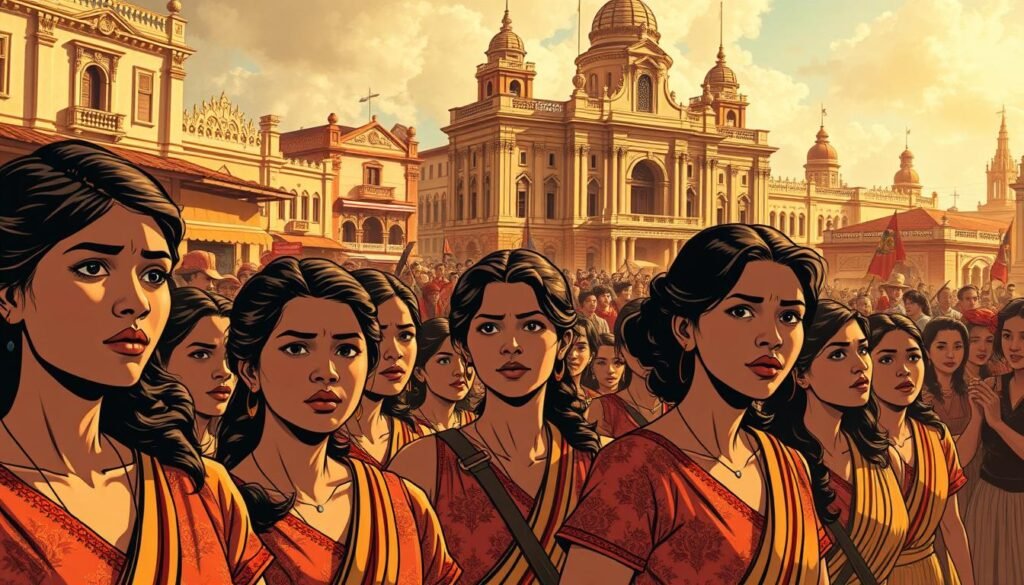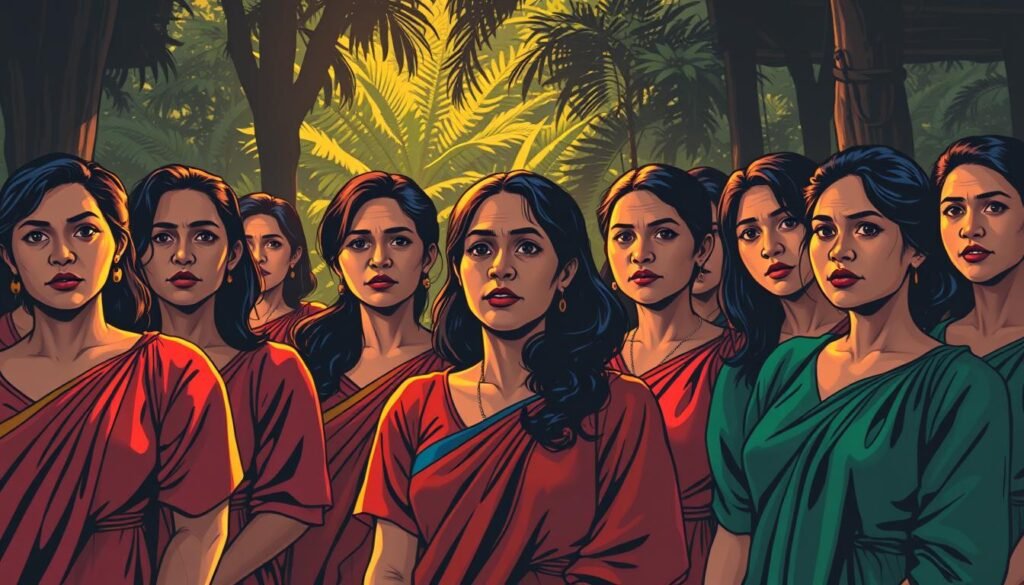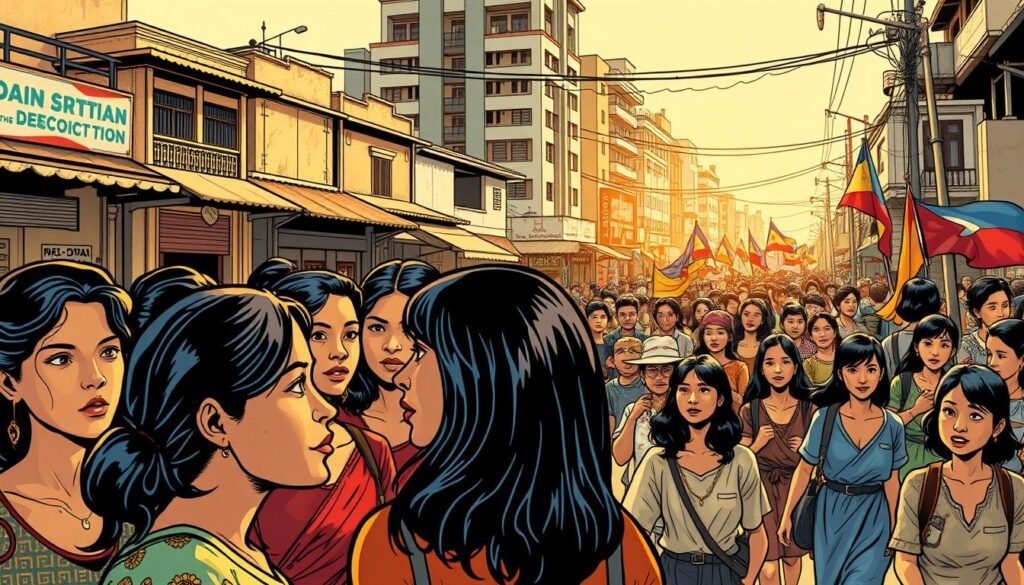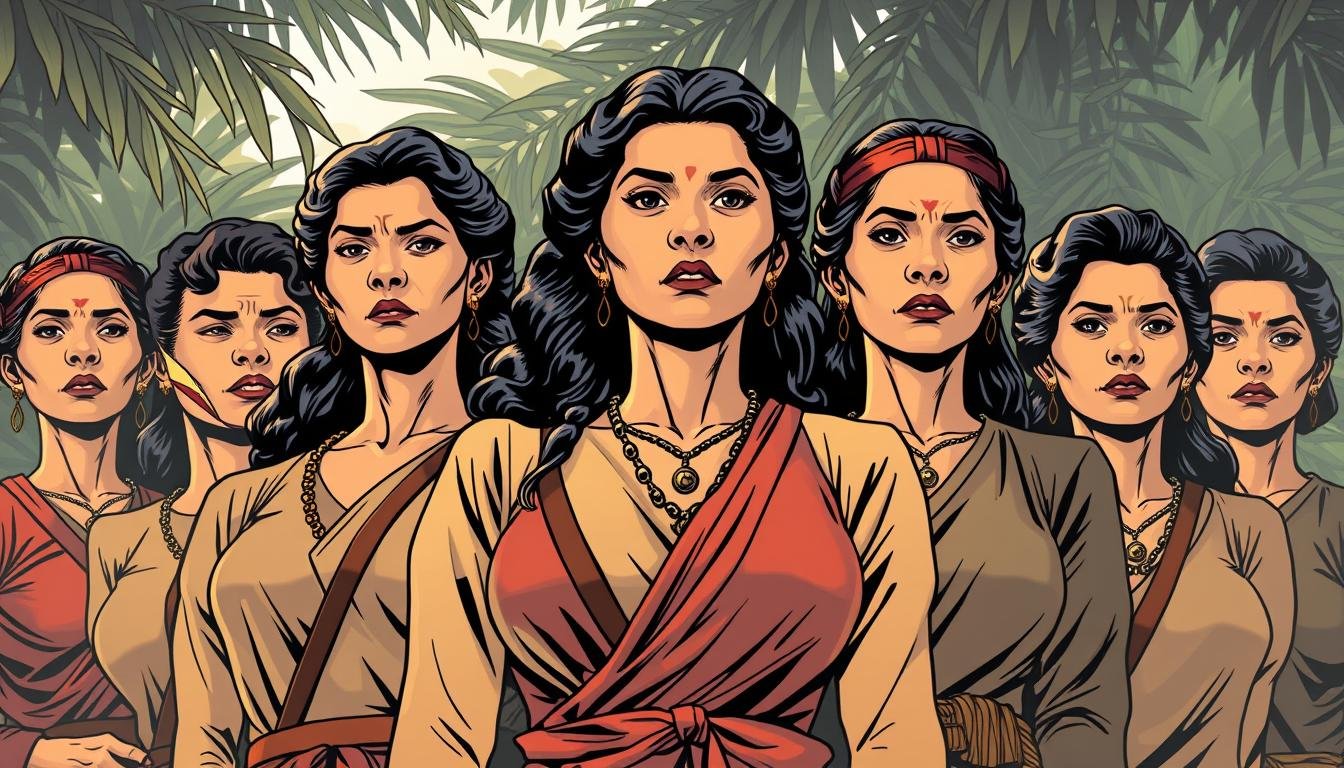Did you know that women make up 43% of the global agricultural labor force? This statistic highlights their undeniable influence across societies. In the Philippines, their impact extends far beyond farming. During the Philippine Revolution, women played a transformative part in shaping the nation’s history.
The revolution, which began in 1896, was not just a fight for independence. It was also a platform for challenging traditional gender norms. Women stepped into roles as soldiers, strategists, and leaders, proving their capabilities in a male-dominated society. Their contributions were pivotal, yet often overlooked in historical narratives.
From Melchora Aquino, known as the “Mother of the Revolution,” to Teresa Magbanua, the “Visayan Joan of Arc,” these women defied expectations. They provided shelter, fought in battles, and even sewed the national flag. Their efforts were instrumental in the fight against colonial rule.
This article explores how women reshaped society during this critical period. It sheds light on their untold stories and celebrates their enduring legacy. Stay tuned to discover the remarkable achievements of these unsung heroes.
Key Takeaways
- Women played a crucial part in the Philippine Revolution, challenging traditional gender roles.
- Figures like Melchora Aquino and Teresa Magbanua were key leaders and contributors.
- The revolution was not just about independence but also about societal transformation.
- Women’s contributions were often marginalized in historical accounts.
- Their legacy continues to inspire modern movements for gender equality.
Historical Context and the Fight for Independence
Colonial rule in the Philippines created a unique socio-political environment that shaped the revolution. The late 19th century was a time of deep cultural and political tensions. Spanish colonization had long suppressed local traditions and imposed foreign values. This backdrop set the stage for a revolution that was as much about reclaiming identity as it was about gaining independence.

Revolutionary Backdrop in Colonial Philippines
The Philippines under Spanish rule was a society marked by inequality. The colonial system favored the elite, leaving the majority of the population in poverty. Men were often seen as the primary decision-makers, while women were relegated to the home. This division of roles was deeply ingrained in the culture and reinforced by colonial policies.
Education was limited, especially for women. Only a small percentage had access to formal schooling, which further restricted their opportunities. Despite these barriers, many women found ways to contribute to their family and community. They managed households, raised children, and supported their husbands in various ways.
Socio-Political Challenges Faced by Women
Women in colonial Philippines faced systemic discrimination. Legal rights were minimal, and societal expectations confined them to traditional roles. The man was often seen as the head of the household, while the woman’s role was to support him. This dynamic left little room for women to participate in public life or political movements.
Cultural norms also played a significant role. The idea of a woman stepping outside her expected role was often met with resistance. Yet, the revolution provided a platform for challenging these norms. Women began to take on roles as strategists, caregivers, and even fighters. Their contributions were pivotal, though often overlooked in historical narratives.
For example, figures like Teresa Magbanua defied societal expectations by leading troops in battle. Her bravery and leadership inspired many, proving that women could be just as capable as men in times of crisis.
These challenges set the stage for women to make an impactful contribution during the revolution. Their efforts not only helped secure independence but also paved the way for future generations to challenge gender norms and fight for equality.
Key Contributions: Role of Women in the Revolution
The Philippine Revolution saw women stepping into roles that defied societal expectations. They were not just passive observers but active participants in the fight for independence. Their contributions ranged from covert operations to direct involvement in battles, proving their resilience and leadership.

Active Participation in Support and Resistance
Women played a crucial part in supporting the revolutionary cause. They provided shelter, food, and medical aid to soldiers. Many risked their lives to deliver messages and supplies, often under the radar of colonial authorities. Their work was essential in keeping the movement alive.
For example, Melchora Aquino, known as the “Mother of the Revolution,” opened her home to wounded fighters. She also used her influence to rally the community around the cause. Her bravery inspired many, proving that women could lead even in the most challenging times.
Innovative Strategies and Undocumented Acts of Bravery
Women also devised creative strategies to resist colonial rule. They organized secret meetings, spread propaganda, and even sewed the national flag. These acts of defiance were often undocumented, but they were critical to the revolution’s success.
Teresa Magbanua, a female leader, led troops in battle and became a symbol of courage. Her innovative tactics and unwavering commitment showed that women could be just as effective as men in warfare. Her story is a testament to the change women brought to the revolution.
| Name | Contribution | Impact |
|---|---|---|
| Melchora Aquino | Provided shelter and support | Inspired community involvement |
| Teresa Magbanua | Led troops in battle | Proved women’s leadership in warfare |
| Gregoria de Jesús | Organized secret meetings | Strengthened revolutionary networks |
These contributions were not just about winning independence. They also challenged traditional gender norms and paved the way for future generations. Women’s involvement in the revolution reshaped national identity and inspired modern movements for equality.
For more on the revolution’s key figures, explore Mariano Llanera’s role in the revolution.
Women as Leaders and Change-Makers
The Philippine Revolution was a turning point for societal norms, especially for women. It provided a platform for them to emerge as leaders and advocates for change. During this turbulent time, they broke free from traditional household roles and assumed positions of power, reshaping the idea of leadership.

Breaking Gender Norms During Turbulent Times
Women like Melchora Aquino and Teresa Magbanua defied societal expectations. Aquino, known as the “Mother of the Revolution,” opened her home to fighters, while Magbanua led troops in battle. Their experiences challenged the prevailing gender norms and redefined what it meant to be a leader.
These women not only supported their husbands but also took charge in critical moments. They proved that leadership was not confined to one gender. Their innovative ideas and actions inspired others to rethink traditional roles in the household and society.
- They organized secret meetings and spread revolutionary propaganda.
- They provided medical aid and shelter to fighters.
- They led troops in battle, proving their capabilities in warfare.
Their contributions had a transformational impact. They paved the way for future generations to challenge gender norms and fight for equality. Today, their legacy continues to inspire modern movements for gender equality.
“Leadership is not about gender; it’s about action and courage.”
Historical accounts and modern interpretations alike highlight the importance of these women. They showed that leadership is about experience, vision, and the willingness to challenge the status quo. Their stories remind us that change begins with the courage to step into new positions and lead by example.
The Broader Impact on Society and Culture
The Philippine Revolution not only fought for independence but also reshaped societal norms, leaving a lasting impact on culture and daily life. Women’s contributions extended beyond the battlefield, influencing family dynamics, education, and labor roles. Their efforts laid the foundation for a more inclusive society.

Influence on Family, Education, and Workforce
Women’s involvement in the revolution transformed traditional family structures. They took on leadership roles, challenging the idea that the home was their only domain. This shift allowed future generations to see women as capable leaders and decision-makers.
Education also saw significant changes. Women who were once denied access to formal schooling began advocating for better educational opportunities. This shift not only empowered them but also benefited their children, who grew up with broader perspectives.
In the workforce, women’s contributions during the revolution paved the way for greater participation in labor. They proved that their skills were invaluable, whether in agriculture, trade, or community organizing. This change helped redefine societal expectations and opened doors for future generations.
Shaping National Identity and Gender Expectations
The revolution redefined what it meant to be Filipino. Women’s active participation challenged traditional gender roles, showing that leadership and bravery were not confined to one gender. This shift in culture helped shape a more inclusive national identity.
Women’s work in nurturing communities also translated into broader economic and cultural growth. Their efforts in organizing and mobilizing resources were critical to the revolution’s success and left a lasting legacy.
Today, their contributions continue to inspire discussions on gender equality and empowerment. As highlighted in this UN Women report, understanding their impact is crucial for building a more equitable society.
Lessons from the Past for Today’s Society
The stories of revolutionary women in the Philippines offer timeless lessons for today’s society. Their courage and leadership during the revolution continue to inspire modern discussions about gender equality and personal agency. By examining their experiences, we can draw meaningful parallels to the challenges and opportunities faced by many woman today.

Parallels in Modern Gender Roles and Leadership
Historically, women were often confined to traditional roles, but the revolution showed their potential as leaders and decision-makers. Today, this idea resonates as more women take on leadership positions in politics, business, and community organizations. For example, women now make up 25% of Congress, a significant increase from previous decades.
Despite progress, challenges remain. Many women still face barriers in the workplace, earning less than their male counterparts. However, the resilience of revolutionary women reminds us that change is possible. Their struggles and achievements continue to shape contemporary discussions about rights and opportunities.
“Leadership is not about gender; it’s about action and courage.”
Real-world examples highlight both similarities and progress. In education, women’s participation has grown, with 77% of public school teachers being female. This mirrors the historical shift where women’s involvement in the revolution led to increased literacy rates. Their contributions in nurturing communities also translate into broader societal growth.
Learning from these historical experiences is crucial for driving future improvements. By reflecting on the empowerment of revolutionary women, we can better understand how to challenge outdated norms and create a more inclusive society. As highlighted in this discussion on gender roles, understanding the past is key to shaping a better future.
Encourage readers to think about how historical empowerment can catalyze change in today’s context. The lessons from the Philippine Revolution remind us that every person has the potential to make a difference, regardless of gender. Their legacy continues to inspire modern movements for equality and justice.
Conclusion
The Philippine Revolution was a turning point where women defied societal norms, proving their capabilities in leadership and labor. Figures like Melchora Aquino and Teresa Magbanua not only fought for independence but also reshaped cultural expectations. Their experience continues to inspire future generations, showing that courage knows no gender.
Historical records and modern analysis highlight how these women challenged traditional roles. They took on positions of power, influencing family dynamics, education, and societal structures. Their contributions remind us that equality is a continuous struggle, bridging the past and present.
As we reflect on their legacy, it’s clear that their efforts laid the foundation for today’s movements. Their stories encourage us to appreciate the multifaceted impact of women on both national and global stages. To learn more about their influence, explore UN Women’s initiatives.
Looking ahead, their achievements remind us that progress requires resilience and unity. Their legacy continues to shape the fight for equality, proving that every generation has the power to create lasting change.
FAQ
What was the historical context of the Philippine Revolution?
The Philippine Revolution took place during the late 19th century under Spanish colonial rule. It was a fight for independence, marked by socio-political challenges and a desire for self-governance.
How did women contribute to the revolution?
Women played a vital role by actively participating in support and resistance efforts. They used innovative strategies and demonstrated acts of bravery, often undocumented, to advance the cause.
Did women break gender norms during the revolution?
Yes, many defied traditional expectations by stepping into leadership roles and taking on responsibilities typically reserved for men during this turbulent period.
What impact did women have on society and culture?
Their efforts influenced family dynamics, education, and the workforce. They also helped shape national identity and challenged existing gender expectations.
Are there parallels between the revolution and modern gender roles?
Absolutely. The courage and leadership displayed by women during the revolution continue to inspire and influence gender equality and leadership in today’s society.
How did the revolution affect the status of women in the Philippines?
It elevated their status by showcasing their capabilities and resilience, paving the way for greater recognition and opportunities in various aspects of life.
Source Links
- The Philippine Revolution and role of Filipinas
- This day in #Herstory: Courageous and strong women of the Katipunan – Foundation for Media Alternatives
- Women in the American Revolution
- The Legacy of the American Revolution for Women’s Rights – The American Revolution Institute
- Women and the Revolution · Explore · LIBERTY, EQUALITY, FRATERNITY: EXPLORING THE FRENCH REVOUTION
- Women and the Revolution | Historical Society of Pennsylvania
- Women leaders make work better. Here’s the science behind how to promote them
- Women Leaders As Change Masters – How To Become One
- Culture
- Feminism and Women’s Rights Movements – Gender Matters – www.coe.int
- The Role of Women in the Industrial Revolution | Tsongas Industrial History Center
- How has the role of women changed over the last 50 years? | USAFacts
- Lesson: The changing role of women | KS3 History | Oak National Academy
- Gender Identity & Roles | Feminine Traits & Stereotypes
- Women’s Rights Caucus: Conclusion of CSW61

